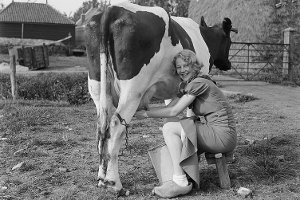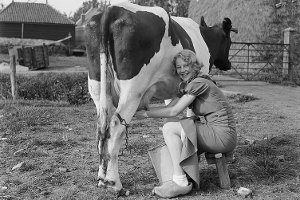Our cells make lactase by reading the lactase gene. In most mammals, this gene gets shut off in adulthood.
The programming for turning the gene off later in life is found in the DNA around the lactase gene. People with lactase persistence have a DNA change that messes with the programming. Now the lactase gene stays on so these folks can keep drinking milk and eating ice cream.
The “on” version is actually dominant over the normal one. In other words, lactose intolerant people need to get the normal lactase gene from both parents. So my wife and I are at least carriers—we can drink milk but carry one normal lactase gene.
I actually know that I am more than a carrier. I have two normal lactase genes even though I can still drink milk. This means that my gene hasn’t shut off yet but that it probably will at some point. Scientists don’t yet know why it shuts off early in some people like my daughter and later for others like me.
So how did some people end up able to drink milk as adults? Mutations and natural selection of course.
Most likely there is always a low level of lactase persistence in any mammalian population. Mutations (or new DNA changes) can and do happen and changes like this in the lactase gene are bound to be pretty neutral. In most situations there won’t be any advantage or disadvantage to having it and so it will stay rare.
This can all change if adults suddenly have to start drinking milk as happened in certain cultures in Europe and Africa. In these places, the few people with the right lactase mutation had an advantage and so did better than the lactose intolerant. Eventually, most people in these places could drink milk as an adult.
What is really interesting to me is the fact that European and African milk drinkers don’t share the same DNA difference. Each population had a distinct lactase mutation that became the norm. This is called convergent evolution—two populations arrive at a similar trait with different DNA changes.
However it happened, my daughter is now adjusting nicely to the milk-soaked culture she finds herself in. There are pills that let her drink milk as well as lactase-treated milk and ice cream. This means she can still have her favorite dessert in the world, chocolate ice cream.
37.7749295 -122.4194155
 If you’re an adult and you can drink milk, then you are a mutant. Image courtesy of Collectie Willem van de Poll, via Nationaal Archief.
If you’re an adult and you can drink milk, then you are a mutant. Image courtesy of Collectie Willem van de Poll, via Nationaal Archief.